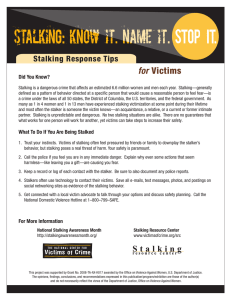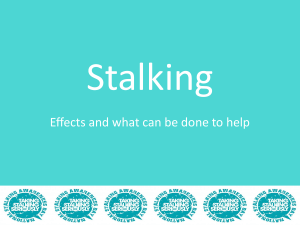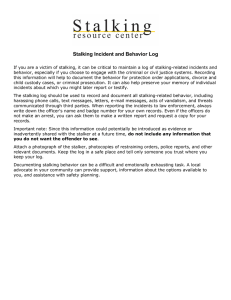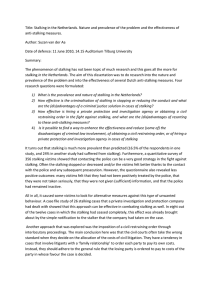stalking fact sheet a
advertisement
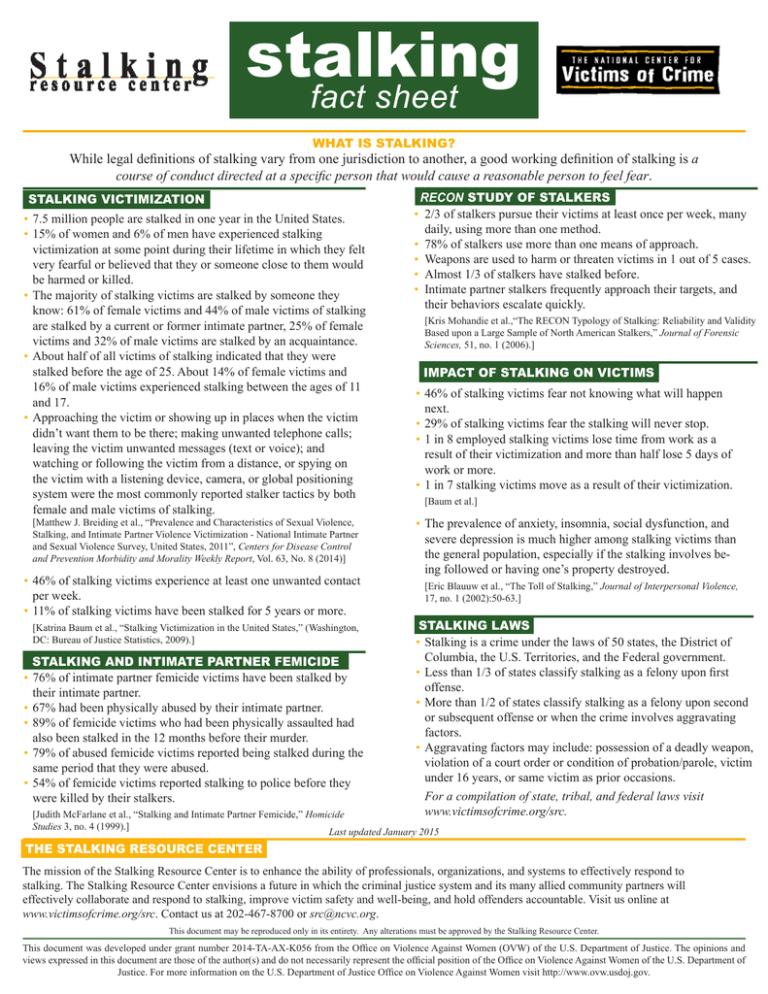
stalking fact sheet WHAT IS STALKING? While legal definitions of stalking vary from one jurisdiction to another, a good working definition of stalking is a course of conduct directed at a specific person that would cause a reasonable person to feel fear. STALKING VICTIMIZATION •7.5 million people are stalked in one year in the United States. •15% of women and 6% of men have experienced stalking victimization at some point during their lifetime in which they felt very fearful or believed that they or someone close to them would be harmed or killed. •The majority of stalking victims are stalked by someone they know: 61% of female victims and 44% of male victims of stalking are stalked by a current or former intimate partner, 25% of female victims and 32% of male victims are stalked by an acquaintance. •About half of all victims of stalking indicated that they were stalked before the age of 25. About 14% of female victims and 16% of male victims experienced stalking between the ages of 11 and 17. •Approaching the victim or showing up in places when the victim didn’t want them to be there; making unwanted telephone calls; leaving the victim unwanted messages (text or voice); and watching or following the victim from a distance, or spying on the victim with a listening device, camera, or global positioning system were the most commonly reported stalker tactics by both female and male victims of stalking. [Matthew J. Breiding et al., “Prevalence and Characteristics of Sexual Violence, Stalking, and Intimate Partner Violence Victimization - National Intimate Partner and Sexual Violence Survey, United States, 2011”, Centers for Disease Control and Prevention Morbidity and Morality Weekly Report, Vol. 63, No. 8 (2014)] •46% of stalking victims experience at least one unwanted contact per week. •11% of stalking victims have been stalked for 5 years or more. [Katrina Baum et al., “Stalking Victimization in the United States,” (Washington, DC: Bureau of Justice Statistics, 2009).] STALKING AND INTIMATE PARTNER FEMICIDE •76% of intimate partner femicide victims have been stalked by their intimate partner. •67% had been physically abused by their intimate partner. •89% of femicide victims who had been physically assaulted had also been stalked in the 12 months before their murder. •79% of abused femicide victims reported being stalked during the same period that they were abused. •54% of femicide victims reported stalking to police before they were killed by their stalkers. RECON STUDY OF STALKERS • 2/3 of stalkers pursue their victims at least once per week, many daily, using more than one method. • 78% of stalkers use more than one means of approach. • Weapons are used to harm or threaten victims in 1 out of 5 cases. • Almost 1/3 of stalkers have stalked before. • Intimate partner stalkers frequently approach their targets, and their behaviors escalate quickly. [Kris Mohandie et al.,“The RECON Typology of Stalking: Reliability and Validity Based upon a Large Sample of North American Stalkers,” Journal of Forensic Sciences, 51, no. 1 (2006).] IMPACT OF STALKING ON VICTIMS •46% of stalking victims fear not knowing what will happen next. •29% of stalking victims fear the stalking will never stop. •1 in 8 employed stalking victims lose time from work as a result of their victimization and more than half lose 5 days of work or more. •1 in 7 stalking victims move as a result of their victimization. [Baum et al.] •The prevalence of anxiety, insomnia, social dysfunction, and severe depression is much higher among stalking victims than the general population, especially if the stalking involves being followed or having one’s property destroyed. [Eric Blauuw et al., “The Toll of Stalking,” Journal of Interpersonal Violence, 17, no. 1 (2002):50-63.] STALKING LAWS •Stalking is a crime under the laws of 50 states, the District of Columbia, the U.S. Territories, and the Federal government. •Less than 1/3 of states classify stalking as a felony upon first offense. •More than 1/2 of states classify stalking as a felony upon second or subsequent offense or when the crime involves aggravating factors. •Aggravating factors may include: possession of a deadly weapon, violation of a court order or condition of probation/parole, victim under 16 years, or same victim as prior occasions. For a compilation of state, tribal, and federal laws visit www.victimsofcrime.org/src. [Judith McFarlane et al., “Stalking and Intimate Partner Femicide,” Homicide Studies 3, no. 4 (1999).] Last updated January 2015 THE STALKING RESOURCE CENTER The mission of the Stalking Resource Center is to enhance the ability of professionals, organizations, and systems to effectively respond to stalking. The Stalking Resource Center envisions a future in which the criminal justice system and its many allied community partners will effectively collaborate and respond to stalking, improve victim safety and well-being, and hold offenders accountable. Visit us online at www.victimsofcrime.org/src. Contact us at 202-467-8700 or src@ncvc.org. This document may be reproduced only in its entirety. Any alterations must be approved by the Stalking Resource Center. This document was developed under grant number 2014-TA-AX-K056 from the Office on Violence Against Women (OVW) of the U.S. Department of Justice. The opinions and views expressed in this document are those of the author(s) and do not necessarily represent the official position of the Office on Violence Against Women of the U.S. Department of Justice. For more information on the U.S. Department of Justice Office on Violence Against Women visit http://www.ovw.usdoj.gov.
